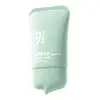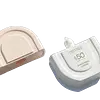What's inside
What's inside
 Key Ingredients
Key Ingredients

 Benefits
Benefits

 Concerns
Concerns

 Ingredients Side-by-side
Ingredients Side-by-side

Water
Skin ConditioningEthylhexyl Methoxycinnamate
UV AbsorberIsoamyl P-Methoxycinnamate
UV AbsorberButylene Glycol
HumectantPropylene Glycol
HumectantPolymethyl Methacrylate
Propylene Glycol Laurate
Skin ConditioningButyl Methoxydibenzoylmethane
UV AbsorberOctocrylene
UV AbsorberBis-Ethylhexyloxyphenol Methoxyphenyl Triazine
Skin ConditioningEthylhexyl Triazone
UV AbsorberPEG-400
Emulsion StabilisingDiethylamino Hydroxybenzoyl Hexyl Benzoate
UV FilterPhenoxyethanol
PreservativeAcrylates/C10-30 Alkyl Acrylate Crosspolymer
Emulsion StabilisingTriethanolamine
BufferingBisabolol
MaskingEthylhexylglycerin
Skin ConditioningCarbomer
Emulsion Stabilising1,2-Hexanediol
Skin ConditioningSodium Hyaluronate
HumectantBiosaccharide Gum-1
HumectantTocopherol
AntioxidantDihydroxyethyl Toluidine
Spirulina Maxima Extract
SmoothingZingiber Officinale Root Extract
MaskingLecithin
EmollientWater, Ethylhexyl Methoxycinnamate, Isoamyl P-Methoxycinnamate, Butylene Glycol, Propylene Glycol, Polymethyl Methacrylate, Propylene Glycol Laurate, Butyl Methoxydibenzoylmethane, Octocrylene, Bis-Ethylhexyloxyphenol Methoxyphenyl Triazine, Ethylhexyl Triazone, PEG-400, Diethylamino Hydroxybenzoyl Hexyl Benzoate, Phenoxyethanol, Acrylates/C10-30 Alkyl Acrylate Crosspolymer, Triethanolamine, Bisabolol, Ethylhexylglycerin, Carbomer, 1,2-Hexanediol, Sodium Hyaluronate, Biosaccharide Gum-1, Tocopherol, Dihydroxyethyl Toluidine, Spirulina Maxima Extract, Zingiber Officinale Root Extract, Lecithin
Zinc Oxide
Cosmetic ColorantCyclopentasiloxane
EmollientPEG-10 Dimethicone
Skin ConditioningPolyglyceryl-3 Polydimethylsiloxyethyl Dimethicone
Skin ConditioningTriethoxycaprylylsilane
Isododecane
EmollientEthylhexyl Methoxycinnamate
UV AbsorberDimethicone
EmollientTitanium Dioxide
Cosmetic ColorantPEG-9 Polydimethylsiloxyethyl Dimethicone
EmulsifyingHydrated Silica
AbrasiveHydrogen Dimethicone
Aluminum Hydroxide
EmollientWater
Skin ConditioningAlcohol Denat.
AntimicrobialEthylhexyl Salicylate
UV AbsorberDiethylamino Hydroxybenzoyl Hexyl Benzoate
UV FilterPolymethyl Methacrylate
Disteardimonium Hectorite
StabilisingPropylene Carbonate
SolventSilica
AbrasiveTrimethylsiloxysilicate
EmollientButylene Glycol
HumectantVinyl Dimethicone/Methicone Silsesquioxane Crosspolymer
Cetyl PEG/PPG-10/1 Dimethicone
EmulsifyingPhenylbenzimidazole Sulfonic Acid
UV AbsorberOctocrylene
UV AbsorberEthylhexyl Triazone
UV AbsorberLauroyl Lysine
Skin ConditioningMethyl Methacrylate Crosspolymer
Aminomethyl Propanol
BufferingSodium Chloride
Masking1,2-Hexanediol
Skin ConditioningParfum
MaskingHydroxyacetophenone
AntioxidantSpirulina Maxima Extract
SmoothingLecithin
EmollientPhenoxyethanol
PreservativeSodium Hyaluronate
HumectantZinc Oxide, Cyclopentasiloxane, PEG-10 Dimethicone, Polyglyceryl-3 Polydimethylsiloxyethyl Dimethicone, Triethoxycaprylylsilane, Isododecane, Ethylhexyl Methoxycinnamate, Dimethicone, Titanium Dioxide, PEG-9 Polydimethylsiloxyethyl Dimethicone, Hydrated Silica, Hydrogen Dimethicone, Aluminum Hydroxide, Water, Alcohol Denat., Ethylhexyl Salicylate, Diethylamino Hydroxybenzoyl Hexyl Benzoate, Polymethyl Methacrylate, Disteardimonium Hectorite, Propylene Carbonate, Silica, Trimethylsiloxysilicate, Butylene Glycol, Vinyl Dimethicone/Methicone Silsesquioxane Crosspolymer, Cetyl PEG/PPG-10/1 Dimethicone, Phenylbenzimidazole Sulfonic Acid, Octocrylene, Ethylhexyl Triazone, Lauroyl Lysine, Methyl Methacrylate Crosspolymer, Aminomethyl Propanol, Sodium Chloride, 1,2-Hexanediol, Parfum, Hydroxyacetophenone, Spirulina Maxima Extract, Lecithin, Phenoxyethanol, Sodium Hyaluronate
Ingredients Explained
These ingredients are found in both products.
Ingredients higher up in an ingredient list are typically present in a larger amount.
1,2-Hexanediol is a synthetic liquid and another multi-functional powerhouse.
It is a:
- Humectant, drawing moisture into the skin
- Emollient, helping to soften skin
- Solvent, dispersing and stabilizing formulas
- Preservative booster, enhancing the antimicrobial activity of other preservatives
Butylene Glycol (or BG) is used within cosmetic products for a few different reasons:
Overall, Butylene Glycol is a safe and well-rounded ingredient that works well with other ingredients.
Though this ingredient works well with most skin types, some people with sensitive skin may experience a reaction such as allergic rashes, closed comedones, or itchiness.
Learn more about Butylene GlycolDiethylamino Hydroxybenzoyl Hexyl Benzoate (DHHB) is a chemical UV-A absorber. It is formulated for high UVA protection (320-400 nm).
DHHB is well-liked for:
DHHB has been approved by the EU, Japan, Taiwan, and South America for use up to 10%. Unfortunately, it has not been approved for use in the US or Canada due to slow regulatory processes.
This ingredient is soluble in oils, fats, and lipids.
Learn more about Diethylamino Hydroxybenzoyl Hexyl BenzoateEthylhexyl Methoxycinnamate is an organic compound that provides UVB protection. It often goes by the more common name of octinoxate. It is created from methoxycinnamic acid and 2-ethylhexanol.
Ethylhexyl Methoxycinnamate absorbs UVB rays with wavelengths between 280-320 nm. UV absorbers protect your skin by using chemical reactions to convert UV rays into heat and energy.
UVB (290-320 nm) rays emit more energy than UVA rays. They are capable of damaging DNA, causing sunburns and are thought to be linked to skin cancer.
The state of Hawaii has banned sunscreens containing octinoxate due to its potential impact on coral reefs. More research is needed to bridge gaps in this research. The European Union allows higher levels of octinoxate in sunscreens than the US and Australia.
Ethylhexyl Methoxycinnamate is oil soluble. It is not stable and may lose efficacy when exposed to sunlight.
Learn more about Ethylhexyl MethoxycinnamateEthylhexyl Triazone is a modern chemical sunscreen that protects from UV-B radiation.
It is the most effective of existing UV-B filters, as it provides the highest level of photo-stable absorption. It protects from the entire UV-B range (280 to 320nm), with it's highest level of protection at 314nm.
Ethylhexyl Triazone is oil soluble, oderless and colorless, which mean it is able to be incorporated into a variety of different formulations.
It is not currently available within the United States due to slow changing FDA regulations. Outside of the US, it is used in formulations at concentrations up to 5%.
Learn more about Ethylhexyl TriazoneLecithin is a term for a group of substances found in the cell membranes of plants, animals, and humans. They are made up of mixture of phospholipids.
This ingredient has emollient and emulsifying properties.
As an emollient, lecithen helps soften the skin and creates a barrier to keep moisture in.
As an emulsifier, it also helps prevent water and oil ingredients from separating. Lecithin can also help ingredients be better absorbed by the skin.
This is because the phospholipids in lecithin produce liposomes. Liposomes help other ingredients get through the skin barrier.
Depending on the source of this ingredient, lecithin may not be fungal acne safe. This is because some sources of lecithin come from soybean oil, which may feed the malassezia yeast that feeds fungal acne.
We recommend reaching out to the brand you are purchasing from to inquire about the source of their lecithin.
Some other names for this ingredient include soy lecithin and deoiled soy lecithin.
Learn more about LecithinOctocrylene protects skin from sun damage. It absorbs UV-B with peak absorption of 304 nm. It is a common sunscreen ingredient and often paired with avobenzone, a UVA filter. This is because octocrylene stabilizes other sunscreen ingredients by protecting them from degradation when exposed to sunlight. Octocrylene is a photostable ingredient and loses about 10% of SPF in 95 minutes.
Octocrylene also acts as an emollient, meaning it helps skin retain moisture and softens skin. It is oil-soluble and hydrophobic, enhancing water-resistant properties in a product.
Those who are using ketoprofen, a topical anti-inflammatory drug, may experience an allergic reaction when using octocrylene. It is best to speak with a healthcare professional about using sunscreens with octocrylene.
The EU allows a maximum of these concentrations:
Learn more about OctocrylenePhenoxyethanol is a preservative that has germicide, antimicrobial, and aromatic properties. Studies show that phenoxyethanol can prevent microbial growth. By itself, it has a scent that is similar to that of a rose.
It's often used in formulations along with Caprylyl Glycol to preserve the shelf life of products.
This ingredient is also known as PMMA. It is a polymer microsphere, composed of tiny, perfectly spherical particles formed from repeating units.
In cosmetics, PMMA is mainly used to give a soft or blurring effect. The transparent particles are able to scatter light and help reduce the appearance of fine-lines and imperfections.
PMMA is also able to enhance the texture of products by add a smooth feel.
Learn more about Polymethyl MethacrylateSodium Hyaluronate is hyaluronic acid's salt form. It is commonly derived from the sodium salt of hyaluronic acid.
Like hyaluronic acid, it is great at holding water and acts as a humectant. This makes it a great skin hydrating ingredient.
Sodium Hyaluronate is naturally occurring in our bodies and is mostly found in eye fluid and joints.
These are some other common types of Hyaluronic Acid:
Learn more about Sodium HyaluronateWe don't have a description for Spirulina Maxima Extract yet.
Water. It's the most common cosmetic ingredient of all. You'll usually see it at the top of ingredient lists, meaning that it makes up the largest part of the product.
So why is it so popular? Water most often acts as a solvent - this means that it helps dissolve other ingredients into the formulation.
You'll also recognize water as that liquid we all need to stay alive. If you see this, drink a glass of water. Stay hydrated!
Learn more about Water